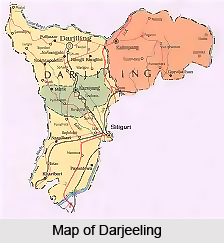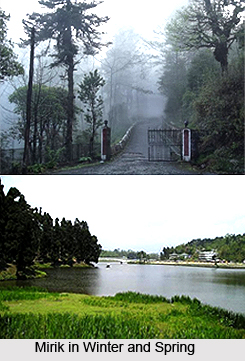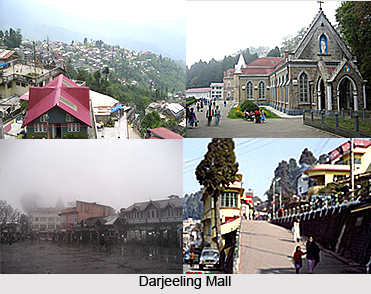 Darjeeling is a town in the Indian state of West Bengal. The breathtaking views, soothing environment and aesthetic appeal of the place attracts hordes of tourists, adventure and nature lovers from all over the world. The name of this town has become iconic with the Darjeeling tea that is produced in the native tea estates of Darjeeling.
Darjeeling is a town in the Indian state of West Bengal. The breathtaking views, soothing environment and aesthetic appeal of the place attracts hordes of tourists, adventure and nature lovers from all over the world. The name of this town has become iconic with the Darjeeling tea that is produced in the native tea estates of Darjeeling.
Location of Darjeeling
The town and hill station of Darjeeling is situated in northern West Bengal. The Darjeeling district lies between 26 degree and 31 minutes and 27 degree 13 minutes north latitude and between 87 degree and 59 minutes and 88 degree and 53 minutes east longitude. Darjeeling rises to a height of 2134m (7053 ft) on a mountain ridge. Darjeeling town mainly comprises of mountainous topography. Darjeeling town covers an approximate area of 11.44 sq. kms.
History of Darjeeling
The history of Darjeeling is closely related with that of Nepal, Bhutan, Sikkim and Bengal. Until the early 19th century, the area around Darjeeling was ruled sporadically by the kingdoms of Nepal and Sikkim, with settlement comprising a few villages of Lepcha woods people. In 1828, a group of British East India Company officials on their way to Sikkim resided in Darjeeling and decided that the region was a suitable site for a sanatorium for British soldiers. The British East India Company negotiated a lease of the area from the Chogyal of Sikkim in 1835. Arthur Campbell, a surgeon with the Company and Lieutenant Napier was given the responsibility to establish a hill station there.
The British established experimental tea plantations in Darjeeling in 1841. Immense successes led to the development of tea estates all around the town in the second half of the 19th century. The British Indian Empire detained Darjeeling a few years after an episode of disagreement between Sikkim and the Company in 1849. During this time, workforce mainly from Nepal, were recruited to work at construction sites, like tea gardens, and on other agriculture-related projects. Scottish missionaries constructed several schools and welfare centers for the British residents, thus laying the foundation for Darjeeling`s high reputation as a centre of education. The opening of the Darjeeling Himalayan Railway in 1881 enhanced the development of the region.
After the independence of India in 1947, Darjeeling was merged with the state of West Bengal. The separate district of Darjeeling was established comprising the hill towns of Darjeeling, Kalimpong, Kurseong, and some parts of the Terrain region. A diverse ethnic population gave rise to socio-economic demand for the creation of the separate states of Gorkhaland and Kamtapur in the 1980s. Political tensions largely lessened with the establishment of the Darjeeling Gorkha Hill Council under the chairmanship of Subash Gishing.
Climate of Darjeeling
The climate of Darjeeling is a temperate one and has five distinct seasons, namely spring, summer, autumn, winter, and the monsoons. Summers start from May and continue till June. Summers are mild, with maximum temperatures rarely crossing 25 degree Celsius. The monsoon season is from June to September is characterised by intense torrential rains often causing landslides that block Darjeeling`s land access to the rest of the country. Umbrellas and rainwears should be carried always in Darjeeling. In winter temperature averages 5-7 degree Celsius (41-44 AøF), with lows around 5 degrees Celsius (23.0 AøF). Occasionally the temperatures drop below freezing; snowfalls are fairly common. During the monsoon and winter seasons, Darjeeling is often enveloped in mist and fog. The annual mean temperature is 12 degree Celsius and the lowest-ever temperature recorded was 5 degree Celsius.
 Culture of Darjeeling
Culture of Darjeeling
The charming culture of Darjeeling is reflected in its people, religion, festivals, food, dance and music traditions. Apart from the major religious festivals of Diwali, Christmas, Dussehra, the diverse ethnic populace of the town celebrates several local festivals like the Lepchas and Bhutias celebrate the New Year (Losar) accompanied by "Devil Dance" in February-March. The Maghe sankranti, Ram Navami, Chotrul Duchen, Buddha Jayanti, the birthday of the Dalai Lama and Tendong Lho Rumfaat are some other festivals celebrated in Darjeeling. Darjeeling Carnival is a ten day carnival held every year during the winter with the high quality portrayal of the rich musical and cultural heritage of Darjeeling Hills as its central theme.
Momo, a steamed dumpling containing pork, beef and vegetables cooked in a doughy wrapping with watery soup as side dish is the most popular food in Darjeeling. Wai-Wai is a packaged snack of pre cooked noodles which are eaten either directly from the packet dry or in soup form. Churpee is another food of Darjeeling that is a kind of hard cheese made from cow`s or yak`s milk is sometimes chewed. A form of noodle called thukpa, is served in soup form. There are a large number of restaurants which offer a wide variety of traditional Indian, continental and Chinese cuisines. Tea and Chhang - a local beer made from millet are the most popular beverages in the region. There are more than 100 tea gardens in Darjeeling. Some of the best gardens are Arya Tea Estate, Singell Tea Gardens, and Margaret`s Hope. Few of the brands selling the finest quality teas are Goodricke, Golden Tips, Kho Cha and so on.
Colonial architecture is witnessed in many buildings in Darjeeling; many Tudor residences, Gothic churches, the Raj Bhawan (Governor House), Planters` Club and various educational institutions are examples. Buddhist monasteries display the pagoda style of architecture. Darjeeling is regarded as a centre of music and a place for musicians and music admirers. Singing and playing musical instruments is a common activity among the resident population, who take pride in the traditions and role of music in cultural life. Western music is popular among the younger generation, and Darjeeling is the hub of Nepali rock music. Cricket and football are the most popular sports in Darjeeling. An improvised form of ball made of rubber garters (called chungi) is often used for playing in the undulating streets.
Tourist Places of Darjeeling
Some notable places to visit in Darjeeling include the Tiger Hill, the zoo, monasteries and the tea gardens. The panoramic town attracts trekkers and sportsmen seeking to explore the Himalayas, serving as the starting point for climbing attempts on some Indian and Nepali peaks. Tibetan crafts like carpets, wood and leather work are displayed in the Tibetan Refugee Self Help Center. Several monasteries like Ghum Monastery (8 km or 5 miles (8.0 km) from the town), Bhutia Busty monastery, Mag-Dhog Yolmowa preserve ancient Buddhist scripts.
Chowrasta in Darjeeling is lined with shops and restaurants; Mall Road, starting and finishing at Chowrasta is best for a leisurely stroll amidst peaceful surroundings and splendid views. Padmaja Naidu Himalayan Zoological Park is home to the Siberian tiger, Himalayan black bear, red panda, snow leopard and many other animal and bird species. The Himalayan Mountaineering Institute, a training center for mountaineers also houses the Everest museum; Natural History Museum, with its excellent display of Himalayan wildlife. Observatory Hill has Hindu and Buddhist shrines; while Dhirdham is a pagoda style Hindu temple. Tiger Hill is renowned for the sunrise view over Kanchenjunga and the eastern Himalayas; and Lloyd`s Botanical Garden has a varied collection of Himalayan flora.
Economy of Darjeeling
The two most significant contributors to Darjeeling`s economy are tourism and the tea industry. Darjeeling tea is regarded as one of the best of black teas and is widely popular all across the globe. More than 60% of workers in the tea gardens are women. The remuneration of workers is often benefited with cash and other necessities like accommodation, subsidised rations, free medical benefits and so on. An ever-growing population of the region has harmfully affected the district`s forests and other natural resources. The years since independence have seen considerable advances in the area`s education, communication and agriculture.
Keeping many of Darjeeling`s residents employed directly and indirectly, tourism has contributed greatly to the economy of Darjeeling. Many people earn a living working for tourism companies and as guides. Darjeeling is a popular filming destination for Bollywood and Bengali cinema. Contributions to the economy also come from the sale of traditional arts and crafts of Sikkim and Tibet.
 Transport of Darjeeling
Transport of Darjeeling
The town of Darjeeling can be reached by the 50 miles (80 km) long Darjeeling Himalayan Railway. This railway is also called the "Toy Train" that commences its journey from Siliguri along the Hill Cart Road (National Highway 55) that follows the railway line. The Darjeeling Himalayan Railway is a 60 cm narrow-gauge railway and was declared as a World Heritage Site by UNESCO in 1999.
Regular bus services and hired vehicles connect Darjeeling with Siliguri and the other important neighbouring towns of Kurseong, Kalimpong and Gangtok. Four wheel drives, including Land Rovers can easily navigate the steep slopes in the region. However, road and railway communications often get discontinued in the monsoons due to landslides. The nearest airport is in Bagdogra near Siliguri, located about 93 km (58 miles) from Darjeeling. Indian Airlines, Jet Airways and Air Deccan are the three prime airlines that connect the area to Delhi, Kolkata and Guwahati. The closest major railway station is in New Jalpaiguri, which is connected with almost all the important Indian cities. Within the town, people usually travel from one place to another by walking. Residents also use bicycle, two-wheelers and hired taxis for traversing short distances. The Darjeeling Ropeway that worked from 1968 to 2003 was stopped after an accident.
Pristine nature and its serenity, captivating sunsets, delicious cuisines, Herculean Himalayas and splendid tea gardens attract numerous tourists who throng the streets of Darjeeling throughout the year.






